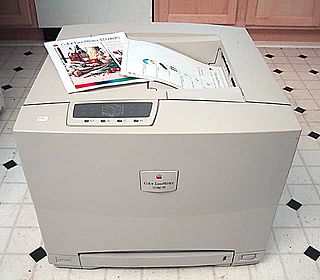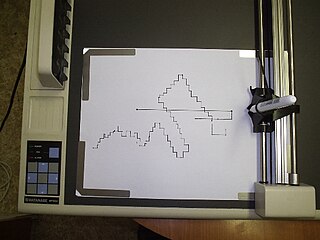AppleTalk is a discontinued proprietary suite of networking protocols developed by Apple Computer for their Macintosh computers. AppleTalk includes a number of features that allow local area networks to be connected with no prior setup or the need for a centralized router or server of any sort. Connected AppleTalk-equipped systems automatically assign addresses, update the distributed namespace, and configure any required inter-networking routing.

In the field of computing, a printer is considered a peripheral device that serves the purpose of creating a permanent representation of text or graphics, usually on paper. While the majority of outputs produced by printers are readable by humans, there are instances where barcode printers have found a utility beyond this traditional use. Different types of printers are available for use, including inkjet printers, thermal printers, laser printers, and 3D printers.

The IBM 3270 is a family of block oriented display and printer computer terminals introduced by IBM in 1971 and normally used to communicate with IBM mainframes. The 3270 was the successor to the IBM 2260 display terminal. Due to the text color on the original models, these terminals are informally known as green screen terminals. Unlike a character-oriented terminal, the 3270 minimizes the number of I/O interrupts required by transferring large blocks of data known as data streams, and uses a high speed proprietary communications interface, using coaxial cable.

A plotter is a machine that produces vector graphics drawings. Plotters draw lines on paper using a pen, or in some applications, use a knife to cut a material like vinyl or leather. In the latter case, they are sometimes known as a cutting plotter.

PostScript is a page description language and dynamically typed, stack-based programming language. It is most commonly used in the electronic publishing and desktop publishing realm, but as a Turing complete programming language, it can be used for many other purposes as well. PostScript was created at Adobe Systems by John Warnock, Charles Geschke, Doug Brotz, Ed Taft and Bill Paxton from 1982 to 1984. The most recent version, PostScript 3, was released in 1997.

The Tandy 1000 is the first in a line of IBM PC compatible home computer systems produced by the Tandy Corporation for sale in its Radio Shack and Radio Shack Computer Center chains of stores. Introduced in 1984, the product line was aimed at providing affordable but capable systems for home computing or education, with some of its Tandy specific features like graphics, sound and joystick port making it more appealing for home use.

The ImageWriter is a product line of dot matrix printers formerly manufactured by Apple Computer, Inc., and designed then to be compatible with their entire line of computers. There were three different models introduced over time, which were popular mostly among Apple II and Macintosh owners.
Zero-configuration networking (zeroconf) is a set of technologies that automatically creates a usable computer network based on the Internet Protocol Suite (TCP/IP) when computers or network peripherals are interconnected. It does not require manual operator intervention or special configuration servers. Without zeroconf, a network administrator must set up network services, such as Dynamic Host Configuration Protocol (DHCP) and Domain Name System (DNS), or configure each computer's network settings manually.

LaserJet as a brand name identifies the line of laser printers marketed by the American computer company Hewlett-Packard (HP). The HP LaserJet was the world's first commercially successful laser printer. Canon supplies both mechanisms and cartridges for most HP laser printers; some larger A3 models use Samsung print engines.
The StyleWriter brand is a line of inkjet serial printers by Apple, targeted mainly towards consumers. They produced print quality that was better than the dot matrix ImageWriters, and were cheaper than the LaserWriters. All but a few models contained Canon print engines, while the last few were re-badged HP Deskjet printers. When Steve Jobs returned to Apple in 1997, he discontinued most of the company's accessory product lines, including the StyleWriter and LaserWriter.
An output device is any piece of computer hardware that converts information/DATA into a human-perceptible form or, historically, into a physical machine-readable form for use with other non-computerized equipment. It can be text, graphics, tactile, audio, or video. Examples include monitors, printers, speakers, headphones, projectors, GPS devices, optical mark readers, and braille readers.

The HP 9800 is a family of what were initially called programmable calculators and later desktop computers that were made by Hewlett-Packard, replacing their first HP 9100 calculator. It is also named "98 line". The 9830 and its successors were true computers in the modern sense of the term, complete with a powerful BASIC language interpreter.

The AT&T UNIX PC is a Unix desktop computer originally developed by Convergent Technologies, and marketed by AT&T Information Systems in the mid- to late-1980s. The system was codenamed "Safari 4" and is also known as the PC 7300, and often dubbed the "3B1". Despite the latter name, the system had little in common with AT&T's line of 3B series computers. The system was tailored for use as a productivity tool in office environments and as an electronic communication center.
DMPL, or Digital Microprocessor Plotter Language, is a vector graphics file format from Houston Instruments developed to control pen plotters and later used on cutting plotters.
Calcomp Technology, Inc., often referred to as Calcomp or CalComp, was a company best known for its Calcomp plotters.

The Color LaserWriter was a line of PostScript four-color laser printers manufactured by Apple Computer, Inc. in the mid-1990s. These printers were compatible with PCs and Apple's own Macintosh line of computers; these printers were also able to connect to large networks by way of the use of an 10baseT Ethernet port. Two models were released.
Atari 8-bit computer peripherals include floppy drives, printers, modems, and video game controllers for Atari's 8-bit computer family, which includes the 400/800, XL, XE, and XEGS.

The Atari 1020 is a four-color computer plotter which was sold by Atari, Inc. for the Atari 8-bit home computers. The 1020 is capable of 20-, 40- and 80-column text and graphics using a friction-fed roll of paper approximately 11.5 cm (4.5 inches) in width. Graphics are generated using one of four coloured pens to draw lines, using a combination of the horizontally moving pen barrel and the vertically scrolling paper to create diagonal lines.

Graphtec Corporation, formerly Watanabe Instruments, is a company for computer input and output devices in Japan. It has subsidiaries in the USA, Europe and Australia. Graphtec was established in 1949; their first plotter was released in 1961.












